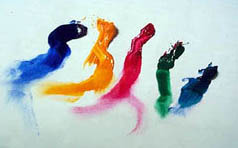|
|
|
|
|
|
|
|
What Exactly is Glazing ? Glazing was widely employed by painters since the invention of oil painting. Although in theory very simple, in practice it can be a very complex undertaking. In the simplest terms glazing consists in brushing a highly transparent layer of paint over another thoroughly layer of dry opaque paint. The underpainting, as the dried layer is usually called, is usually monochromatic but it can also be colored. The two layers of paint are not physically, but optically mixed. It is very similar to placing a sheet of colored acetate over a monochrome photograph. Glazing creates a unique "shine through" stained glass effect that is not obtainable by direct mixture and application of paint. The paint used to glaze must be diluted by an oil to achieve the correct fluidity for brushing. It is insufficient to know how a glaze is to be applied, one has to determine with the utmost precision, how thick or thin the glaze-paint should be, a little too scanty or a trifle too lavish an application can change a color or shade to an important degree. The same holds true for the underpainting which must also be brought to its final degree of detail since once glazed, it can no longer be corrected easily. Why Glaze? Glazing was basically utilized for two reasons. One, the artist had very few of the brilliant colors that he has today. Two, it created, as we have said, an extraordinarily deep luminosity impossible to achieve otherwise. In order to appreciate this effect one has to view the painting directly as no reproduction can convey its jewel-like quality. Glazing, however, has more than one drawback. It is very difficult to accurately anticipate the exact chromatic effect the glazed area will have in the overall harmony of the finished work. It also tends, due to its transparency, to attract the viewer's eye more than the surrounding painted surfaces. For these reasons glazing was not used for other than very specific areas of the painting. Lastly, as we have already said, glazing gives its maximum results only if the glazed layer is painted with very transparent paint and in the past there were very few of them available to painters. Today there are various studies which discuss glazing. However, they probably tend to overstate its use and do not distinguish between glazing used as a corrective measure ( very light glazes meant only to slightly alter the underlying paint layer ) and true glazing which instead aims to create a very specific and otherwise unachievable pictorial effect. Therefore, corrective glazing should not be considered a technique in itself because it does not have a clear pre-planned aim. This difference might not seem a fundamental one but the idea that Vermeer, or any other painter, built up his paintings in a series of successive glazes is entirely incorrect and creates a distorted perception of his painting methods. Most of his paintings were created by straightforward opaque or semi-opaque paint layers, the preplanned glazing process was limited. Most Dutch painters like Vermeer, used glazing very selectively. Painting Materials The majority of seventeenth-century Dutch painters still hand made their own paint. However, recent evidence points to a growing dependence on commercially prepared artist's materials such as stretched canvases and processed pigments. The pigment (the actual coloring substance of paint) was ground together with poppy, nut or linseed oil to form a very stiff paste, thicker than modern paints. In order to glaze properly, the paint had to be made more fluid for brushing. Painters usually used for this purpose either stand oil or Venice turpentine. Stand oil is linseed oil heated to 550░. It is transformed into a heavy viscous material about the consistency of honey. It is non-yellowing and possesses a striking property; it forms an enamel-like film free of brush strokes. It imparts the same tendency to paints when added to them. This makes it indispensable to the glazing process. Venice turpentine has similar characteristics and has the odor of pine wood. |
stand oil |
Pigments Suited for Glazing  Ultramarine Blue Made from crushed lapis lazuli, this precious pigment was one of Vermeer's favorite colors. Although it is very suitable for glazing, he instead, mixed it with flake white producing the many remarkable shades of blue for which he is so well known. Due to its high cost most of Vermeer's contemporaries used a cheaper but lower quality blue known as azurite. Yellow Lake (perhaps Weld) A number of transparent yellow lakes were available for the painter. Weld, a yellow lake detected in the background Vermeer's Girl with a Pearl Earring, was made from the petals and stems of the weld flower. Weld was also widely used as a dye for clothing. Red Madder Red madder is extracted from the root of the madder plant grown in southern Europe and Turkey. It was used as a textile dye in ancient Egypt, Greece and Rome. It has a wonderful deep ruby red color and is sufficiently permanent. It is excellent for glazing and for direct mixture with other colors. Verdigris A bluish green that dates back from ancient Roman times made from copper and vinegar. It seems that Vermeer did not use this pigment. He preferred glazing yellow over blue to create his greens. Indigo A deep transparent blue obtained from the indigo plant cultivated in India. Vermeer used it very sparingly in some of his early works.
click
here for books about the technique of Vermeer and the Great Masters |
|
< previous
next > |
click here for books about the technique of Vermeer and the Great Masters |